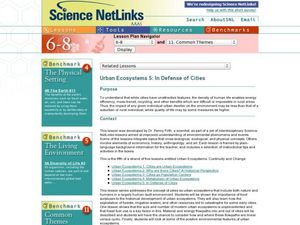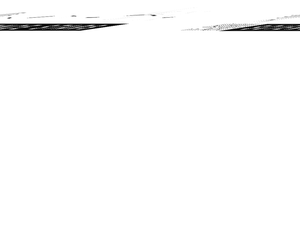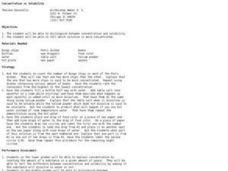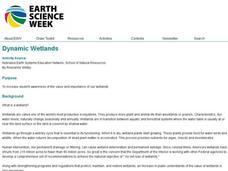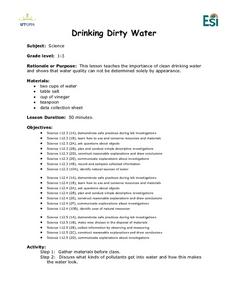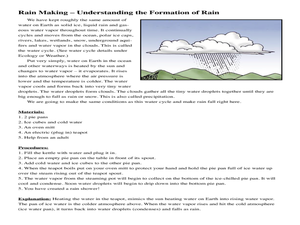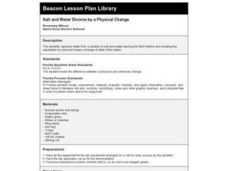Biology Junction
Plasma Membrane – Gateway to the Cell
Just as skin covers your body limiting what can go in and out, plasma membranes cover cells to do the same. Scholars begin with a presentation that gives overview of the structure and function of plasma membranes. Then, they learn how...
Curated OER
What's Gotten Into You?
Students use models to investigate the process and consequences of water contamination on the land, groundwater, and plants.
Curated OER
Water and Ice
Young scholars investigate what happens to solids and liquids when they change from one form to another. The amount od space taken by frozen water begins the discussion and students are led to formulate their own hypothesis to research.
Curated OER
Water, Water Everywhere
Studetns view a terrarium with water droplets on the wals. They discuss the ways the water could have got onto the wall of the terrarium. Learners design an experiment to duplicate the process. They describe the patterns form their data...
Curated OER
Matter: Build a Word
Fourth graders examine matter and the periodic table of elements. In this matter lesson, 4th graders discuss atoms and their composition. Students explore the periodic table of elements and use it to spell words out of the elements.
Curated OER
Go Jump In The Lake!
Learners experiment with local lake water to determine the health of the lake waters. They explore the human impact on the lake water, hypothesize and share inferences in a scientific report.
Curated OER
What is Everything Made of?
Students observe a demonstration on how we see space between water molecules. In this experimental lesson students discover what elements make up the things around them and discuss what they learned.
Curated OER
The Blizzard of 1993
Students read and interpret the information from a barograph from a major winter storm. This task assesses students' abilities to interpret and analyze graphs, construct data tables and graphs, generalize, infer, apply knowledge of...
Curated OER
Ocean Currents
Learners discover the geography of Earth by analyzing water currents. In this oceanography lesson plan, students create visual references on a map of the globe where and why major ocean currents are moving water. Learners...
Curated OER
Making "Cents" of Surface Tension
Students explore the unique behaviors of water. They investigate surface tension using water drops on a penny and pennies dropped in a cup.
Curated OER
Oil + Water + Wildlife = A Real Mess
Middle schoolers conduct an experiment. In this environmental protection lesson, students explore how oil spills affect living organisms in an ecosystem. Middle schoolers work in groups to complete a lab activity and then discuss their...
Curated OER
Monitoring River Levels
In this environmental science learning exercise, students read and study water maps from an interactive website to complete 8 short answer questions that follow.
Curated OER
Concentration vs. Solubility
Students investigate the concentrations of solutions and solubility. For this concentrations and solubility lesson plan, students compare solutions of talcum powder in water and salt in water to have a visual of solubility. They perform...
Curated OER
What is an Aquifer?
Students examine how an aquifer operates. They discuss the implications of the groundwater becoming contaminated. They work together to create an aquifer model to observe the connection between surface water and groundwater.
Curated OER
Dynamic Wetlands
High schoolers construct and observe a model of two different types of wetlands. In this wetlands lesson, students create a model of a wetland with constant drainage and a wetland that maintains a well-saturated soil. High schoolers...
Curated OER
Drinking Dirty Water
Students consider the importance of clean drinking water. They conduct a taste experiment with water, adding incremental drips of salt and vinegar to determine at which point it doesn't taste drinkable.
Curated OER
Flow Rates of Faucets and Rivers
Students work together to discover the flow rates of faucets and rivers. They relate their results to engineering and applied science concepts. They make predictions on the flow rate of a nearby river in their local community.
Curated OER
Up, Up, and Away
Learners create a model to explore the water cycle. Students also perform different experiments to witness water changing from a liquid to a gas. Learners are asked to if they can find ways for water to go away without pouring the...
Curated OER
Rain Making - Understanding the Formation of Rain
Students read and conduct and experiment to learn about rain formation. In this water forms lesson plan, students read about the formation of rain and its purposes. Students then complete a rain experiment activity.
Curated OER
Wat-er We Good For?
Fifth graders investigate the use of water as a resource that needs to be conserved. They practice the skill of water conservation by taking a home survey of water usage and modify the use in order to decrease the wasting of water.
Virginia Department of Education
Matter and Energy: Equations and Formulas
Using simple materials, an informative lesson demonstrates the Law of Conservation of Matter and explains how to balance chemical equations. Young chemists perform experiments, analyze reactions, and balance chemical equations...
Curated OER
Watersheds and Wetlands
Students investigate watersheds and wetlands. In this watersheds and wetlands lesson, students complete a 17 step lesson plan to build a watershed. Students then complete another 9 step lesson to build a watershed with wetlands and...
Curated OER
THe Decomposition of Water
Students collaborate in an experiment where they decompose water into simpler substances through the process of electrolysis. They collect, measure, and observe data and then place the data into a table. Accomodations for students with...
Curated OER
Salt and Water Divorce by a Physical Change
Students discuss the definitions of physical and chemical properties and changes. They vaporize a solution of salt and water, observing the sodium chloride that is left behind.


